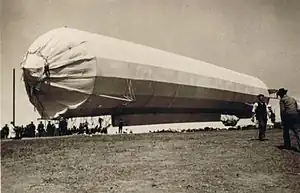Zeppelin LZ 5
The Zeppelin LZ 5, tactical number Z II, was a German experimental military rigid airship constructed under the direction of Ferdinand von Zeppelin. After having made numerous successful trips, LZ 5 broke loose from its moorings in a storm and subsequentely crashed on 25 April 1910.[1][2][3]
| Zeppelin LZ 5 | |
|---|---|
 | |
| LZ 5 after hasty repairs from colliding with a pear tree in 1909. | |
| Role | Type c Experimental military rigid airship |
| National origin | Imperial Germany |
| Manufacturer | Luftschiffbau Zeppelin |
| Designer | Ferdinand von Zeppelin |
| First flight | 26 May 1909 |
| Retired | 25 April 1910 |
| Status | Destroyed in crash |
| Primary user | Kaiserliche Marine |
| Number built | 1 |
Construction
LZ 5 was a C-Class zeppelin built by Luftschiffbau Zeppelin in Manzell near Friedrichshafen, Germany. She was laid down in 1908 and completed by 26 May 1909. The airship measured 136 m (446 ft) in length and had a diameter of 13 m (43 ft). She was equipped with two Daimler engines, producing 105 hp and 77 kW each. The airship could reach a speed of 13.5m/s (48.6 km/h) and a maximum height of 1,250 m (4,100 ft). LZ 5 had a gas volume of 15,000 m³ of hydrogen contained in the envelope of the airship. Her framework was made of the light alloy aluminium and covered by fabric skin. She was equipped with two gondolas and could carry a crew of eight.[4]

Career
LZ 5 conducted its first flight on 26 May 1909 at Lake Constance, Germany. After which she made a successful endurance journey from 29 May to 2 June 1909 under the command of Ludwig Dürr and carrying Ferdinand von Zeppelin and six of his employees, travelling the long distance between Lake Constance and Bitterfeld, Germany and back.[5][6] Its initial goal had been to reach Berlin, but due to fuel shortage and strong headwinds, the airship had to turn back. In total LZ 5 flew for 1,194 km in 38 hours and 40 minutes. However a small incident occurred during this flight, when the airship collided with a pear tree near Göppingen, Germany, rupturing three gas cells. The damage was quickly patched up with some hop sticks and after Captain Dürr returned to the repaired ship after having gone off to buy a chocolate bar, the airship made it back to Lake Constance without further incident.[7][8]
After LZ 5 was fully repaired, it was sold to the military administration in Cologne, Germany on 5 August 1909 and renamed Z II.[9] During her relocation from Lake Constance to Cologne for her military service, the airship made a stop at the International Aviation Exhibition in Frankfurt am Main, Germany. During her time in the army, Z II made a total of 16 more trips, covering a total distance of 2,478 km.[10]

Loss
On 24 April 1910 Z II was travelling from Bad Homburg, Germany to Cologne, Germany when a powerful storm arose, forcing the airship to land in an open field near Limburg an der Lahn, Germany. The airship was moored to a large farm trailer from the nearby Blumenrod farm, but the strong winds managed to break Z II loose from her moorings, after which she drifted aimlessly without crew. The airship ultimately crashed into a hill named Webersberg near Weilburg, Germany.[11] The crash had broken the airship in two and was deemed a total loss. Z II was scrapped on site and 22 commemorative medals were minted from aluminium debris that was salvaged during the scrapping of the airship.[12][13]
Specifications
Data from [14]
General characteristics
- Length: 136 m (446 ft 2 in)
- Diameter: 13 m (42 ft 8 in)
- Volume: 15,000 m3 (530,000 cu ft)
- Powerplant: 2 × Daimler engines , 77 kW (105 hp) each
Performance
- Maximum speed: 48.6 km/h (30 mph, 26 kn)
- Endurance: 38 hours and 40 minutes
 LZ 5 over the Bodensee in 1909.
LZ 5 over the Bodensee in 1909.-7331.jpg.webp) Front side of the commemorative medal minted in 1910.
Front side of the commemorative medal minted in 1910.-7332.jpg.webp) Back side of the commemorative medal minted in 1910.
Back side of the commemorative medal minted in 1910. LZ 5 leaving the floating balloon hall before her first flight on Lake Constance, Germany in May 1909.
LZ 5 leaving the floating balloon hall before her first flight on Lake Constance, Germany in May 1909.
References
- "Sterowce Zeppelin 1900-39". zeppelin.mariwoj.pl. Retrieved 25 November 2022.
- Stephenson, Charles (20 March 2012). Zeppelins: German Airships 1900–40. ISBN 9781780965123. Retrieved 25 November 2022.
- "WW1 aircraft performance and weight investigation info". aircraftinvestigation.info. Retrieved 25 November 2022.
- "26 May 1909". thisdayinaviation.com. Retrieved 25 November 2022.
- "Ludwig Dürr". airships.net. Retrieved 25 November 2022.
- Belafi, Michael Belafi (31 March 2015). The Zeppelin. ISBN 9781473827851. Retrieved 25 November 2022.
- "Skeleton of the German Zeppelin airship 'LZ 5', 1909". timelineimages.sueddeutsche.de. Retrieved 25 November 2022.
- "110 years ago: The legendary pear tree ride of the LZ 5". blog.zeppelin-museum.de. Retrieved 25 November 2022.
- "De Duitse luchtstrijdkrachten in 1914". luchtvaartgeschiedenis.be. Retrieved 25 November 2022.
- "Zeppelin LZ 5". zeppelinhistory.com. Retrieved 25 November 2022.
- "Airship Monuments in Germany-page 1". welweb.org. Retrieved 25 November 2022.
- "ASN Wikibase Occurrence # 834". aviation-safety.net. Retrieved 25 November 2022.
- "Medaille: Aus dem Aluminium des bei Weilburg am 25. April 1910 verunglückten Luftschiffes LZ 5 - Z II". westfalen.museum-digital.de. Retrieved 25 November 2022.
- "Graf Zeppelin in Cologne". luftfahrtarchiv-koeln.de. Retrieved 25 November 2022.
Further reading
- Brooks, Peter W. Zeppelin: Rigid Airships 1893–1940, Washington, D.C.: Smithsonian Institution Press, 1992 ISBN 1-56098-228-4